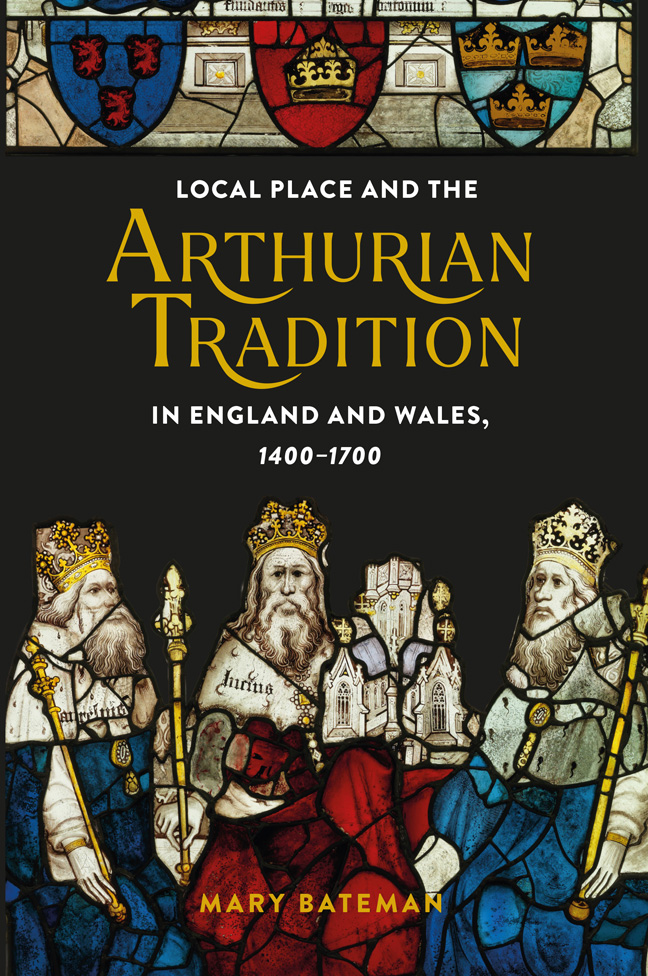Book contents
- Frontmatter
- Contents
- List of Illustrations
- Acknowledgements
- Introduction: Place and the defence of Arthur
- 1 ‘Thise were his places and his habitacions’: Arthur in situ in the fifteenth century
- 2 Contentious places: Reconciling Arthurian places in the fifteenth century
- 3 The best of the west: John Leland's West Country Arthur
- 4 Locating Arthur in England and Wales: John Leland, John Prise, and Elis Gruffydd
- 5 Placing Arthur in William Camden's Britannia
- Coda: Arthur's local renaissance?
- Bibliography
- Index
- Miscellaneous Endmatter
Coda: Arthur's local renaissance?
Published online by Cambridge University Press: 21 February 2024
- Frontmatter
- Contents
- List of Illustrations
- Acknowledgements
- Introduction: Place and the defence of Arthur
- 1 ‘Thise were his places and his habitacions’: Arthur in situ in the fifteenth century
- 2 Contentious places: Reconciling Arthurian places in the fifteenth century
- 3 The best of the west: John Leland's West Country Arthur
- 4 Locating Arthur in England and Wales: John Leland, John Prise, and Elis Gruffydd
- 5 Placing Arthur in William Camden's Britannia
- Coda: Arthur's local renaissance?
- Bibliography
- Index
- Miscellaneous Endmatter
Summary
This book's central line of enquiry has been to investigate how Arthur became localised in England and Wales between the fourteenth and seventeenth centuries, and to understand the role played by local places in defending the impression of Arthur's reality. Ultimately, the ideas still held today about Arthur's local places can be traced back to onsite encounters with Arthur in the later Middle Ages. These continuities challenge the assumption that the local Arthur emerging at the end of the period was a sign of the king's waning importance. How do we define what is important? If we take “importance” to mean something that not only endures but continues to grow organically, then we might well say that the local Arthur is more important than Arthur the national or imperial symbol. Most people today cannot identify with the idea of Arthur as a conqueror of Europe, nor as an imperial icon, but they can identify with the Arthur of the landscape, of Iron Age camps, of their hometown legends: a local Arthur. Modern-day pilgrims still flock to Glastonbury to look at Arthur's grave and experience the new Arthurian associations that have appeared in and around the town since Camden's time of writing. The localisation of Arthur was not a retreat, but a renaissance.
No longer can we simply say that Arthur grew increasingly unpopular from the end of the Middle Ages, nor can we refer dismissively to his localisation as a retreat into unimportance. Rather, this was the time in which the local Arthur as we most often recognise him today emerged. The continuities between local experiences of Arthurian sites in the fifteenth century, defences of Arthur in the sixteenth century, and the major chorographical works of the late sixteenth and early seventeenth centuries partly concern the geographies themselves – the Arthurian locations that were handed down and became established – but they also relate to the ways in which Arthurian places were experienced. Writers used their personal experiences of Arthurian sites to shape their work alongside the writings of their contemporaries and predecessors who had also visited such locations. Thus, the local visions of Arthur that we inherit today are inflected with the echoes of Camden's own site experiences, those of his predecessors, and the antiquarians who came after and read their work.
The use of place in defence of Arthur began in situ at Arthurian sites themselves.
- Type
- Chapter
- Information
- Publisher: Boydell & BrewerPrint publication year: 2023



